Plum Creek, Cecil County
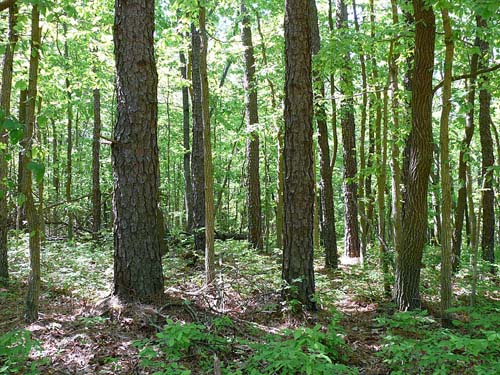 Nestled in the heart of the Elk Neck peninsula is Plum Creek Natural Area. Within this Natural Area exists an exceptional pitch pine (Pinus rigida) community. Pitch pine forests such as these are known from portions of the New Jersey Pine Barrens but are now rare in Maryland. On the Maryland Coastal Plain, pitch pine has a very limited distribution and is primarily restricted to very dry and sandy, acidic habitats subject to periodic fires. Mixed within the tall pitch pines are an assortment of native oaks, along with an understory of huckleberries and blueberries. In early spring, pink lady's-slipper orchids provide splashes of color to the landscape, while skinks and other reptiles roam through the forest. In contrast to the dry pitch pine community, the Plum Creek watershed also contains seepage wetlands and vernal pools. These two habitat types are breeding havens for dragonflies and amphibians alike. Visitors can enjoy the landscape by hiking old logging roads that course through the forest.
Nestled in the heart of the Elk Neck peninsula is Plum Creek Natural Area. Within this Natural Area exists an exceptional pitch pine (Pinus rigida) community. Pitch pine forests such as these are known from portions of the New Jersey Pine Barrens but are now rare in Maryland. On the Maryland Coastal Plain, pitch pine has a very limited distribution and is primarily restricted to very dry and sandy, acidic habitats subject to periodic fires. Mixed within the tall pitch pines are an assortment of native oaks, along with an understory of huckleberries and blueberries. In early spring, pink lady's-slipper orchids provide splashes of color to the landscape, while skinks and other reptiles roam through the forest. In contrast to the dry pitch pine community, the Plum Creek watershed also contains seepage wetlands and vernal pools. These two habitat types are breeding havens for dragonflies and amphibians alike. Visitors can enjoy the landscape by hiking old logging roads that course through the forest.
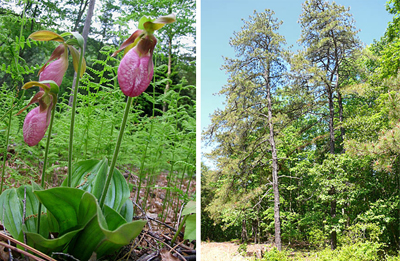
Historically, this forest type likely covered 20,000 acres in Cecil County but was periodically logged for timber and charcoal production. In the early 1900s, this region of Elk Neck came to be known as the "barrens" because of the poor soils and brush fires resulting from charcoal production operations. Other natural forests of pitch pine and oak can be found in Prince George's and Anne Arundel Counties. Plum Creek Natural Area encompasses nearly 500 acres and lies within Elk Neck State Forest, managed by the Maryland Forest Service.
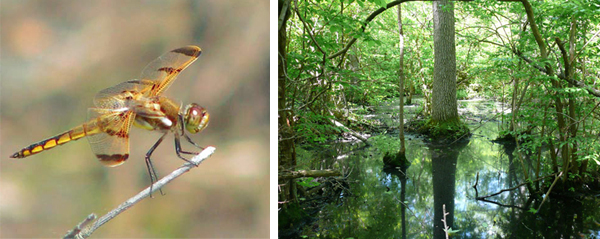
Seasonal Pools
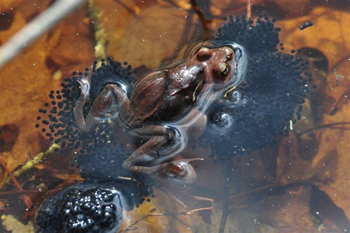 Vernal pools are temporary wetlands that fill up with water from snow melt in late winter and early spring. Because these wetlands are not permanent, fish (some of which are predatory and eat amphibian larvae like tadpoles) cannot establish in them, making the pools breeding refuges for a multitude of amphibian species. In the early spring, listen for a chorus of frogs and check the pools for egg masses and tadpoles.
Vernal pools are temporary wetlands that fill up with water from snow melt in late winter and early spring. Because these wetlands are not permanent, fish (some of which are predatory and eat amphibian larvae like tadpoles) cannot establish in them, making the pools breeding refuges for a multitude of amphibian species. In the early spring, listen for a chorus of frogs and check the pools for egg masses and tadpoles.
Fire-dependent Ecosystem
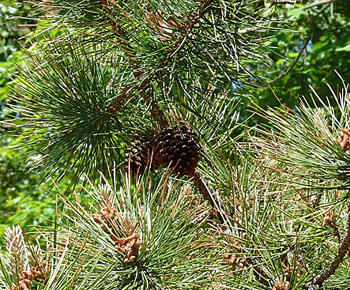 Pitch pine forests are fire-dependent ecosystems. Pitch pines, with their exceptionally thick bark and ability to resprout at the trunk, are structurally adapted to survive fires. At one time, natural fires would spread through these forests, allowing the pitch pine to survive while limiting the growth of hardwood species it normally competes with. Fire is also necessary for the pines to reproduce; the cones usually open up to disperse the seeds only after exposure to fires. Suppression of these natural fires has led to a decline of these special ecosystems.
Pitch pine forests are fire-dependent ecosystems. Pitch pines, with their exceptionally thick bark and ability to resprout at the trunk, are structurally adapted to survive fires. At one time, natural fires would spread through these forests, allowing the pitch pine to survive while limiting the growth of hardwood species it normally competes with. Fire is also necessary for the pines to reproduce; the cones usually open up to disperse the seeds only after exposure to fires. Suppression of these natural fires has led to a decline of these special ecosystems.
Click here for a Print Version of this map.
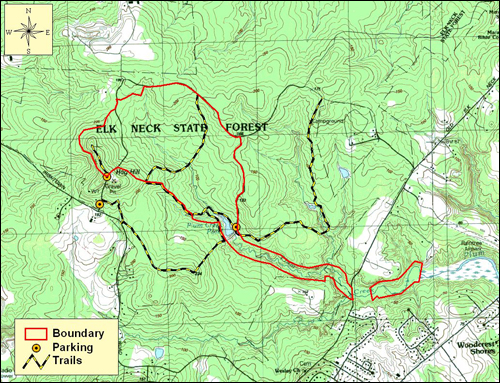
Special Note: Plum Creek Natural Area is used seasonally by hunters.
Directions
From North Baltimore: Travel I-695 (Baltimore Beltway) to Exit 33 at I-95 and head north about 35 miles. Take Exit 100 onto MD 272 (North East Road) south to the town of North East. After crossing MD 7 (in 0.5 mile), continue another 0.6 mile and turn left (east) onto Irishtown Road. Follow Irishtown Road southeast about 1.7 miles to Elk Neck State Forest entrance. Turn left and proceed north to one of several small parking areas.


Driving directions and aerial views open with Google Maps. For the aerial view button, if an aerial view does not open by default, click on the Satellite icon in the upper right corner and Google Maps will switch to an aerial view of the Natural Area.

Acknowledgments
Scenic View of Plum Creek. Photo by: Jason Harrison
Wildlife Collage One: (left to right)
Pink lady's-slippers are named for the color of their distinctive moccasin-shaped flowers. Photo by: Kerry Wixted
Pitch pines can still be found among the mixed deciduous trees and shrubs at �Plum Creek. Photo by: Jason Harrison
Wildlife Collage Two: (left to right)
Dragonflies like this painted skimmer thrive in vernal pools. Photo by: Kerry Wixted
Plum Creek's seepage wetlands and vernal pools are a beautiful and sharp contrast to its dry pitch pine and oak forests. Photo by: Jason Harrison
A pair of wood frogs with eggs in a vernal pool. A close look reveals the smaller, darker male sitting on the female's back. Photo by: USFWS
The cones of pitch pines depend on natural fires for seed dispersal. Photo by: Jason Harrison